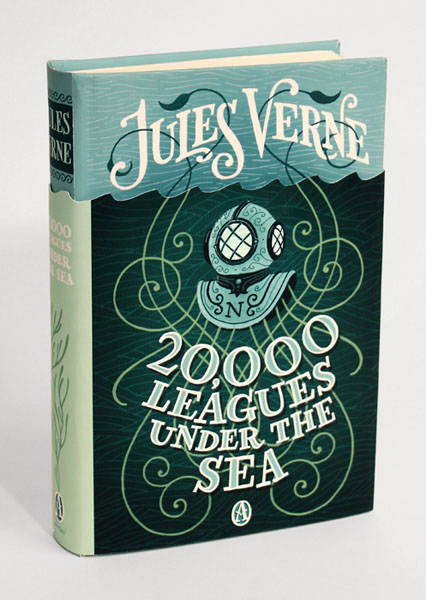For his
senior thesis, designer Jim Tierney developed four book covers to
suit Jules Verne's classic books. What drew me to these designs (apart from
their obvious beauty) was how Tierney introduces design on an interactive level.
20,000
Leagues Under The Sea
For
his design of 20,000
Leagues Under The Sea, Tierney
incorporated a half-jacket, which, once
removed, reveals further artwork.
This
Jules Verne book deals a lot with mystery, discovery and the unknown,
therefore the removable jacket is not simply there for decoration; it
also reinforces these themes from 20,000
Leagues Under The Sea. For,
when you remove the jacket, other animals are revealed. Two giant
squids lie in wait and, on the back, fish hide in the seaweed above
the ruins of a sunken ship and a lost building.
Immediately,
the viewer is drawn into the story. What else will be discovered?
they might ask, therefore opening the book to find out just that.
Journey to the Center
of the Earth
A
similar technique has also been used for his
design on Journey to the Center
of the Earth. A
jacket of translucent film wraps around this book, creating a further
unique texture and a darker colour to the soil of the illustration.
When the film is placed against the lighter colours of the cover,
dinosaur bones and fossils are also revealed; Tierney again uses the
physical aspect of the book to heighten the mystery before you even
begin to read the story.
The
removal of the translucent film allows you to find hidden, peculiar artifacts, which Tierney explains, “hint at some of the more
surprising discoveries made in the story.”
From
The Moon To The Earth
Tierney
takes this interactive level further with his design for From
The Moon To The Earth.
Furthering the “interactive papercraft” idea, Tierney uses a
sliding paper tab to reveal an illustration of a rocket,
something
which could also possibly interest a younger audience to this classic
book.
This
is something that I have never before seen in book design, not out of
children's book design anyway, but there is no doubt how affective this
technique is. The mature design and colours also keeps the interest
of an older audience.
Around
The World In Eighty Days
The
book cover for Around
The World In Eighty Days (my
personal favourite of the Jules Verne novels) has been designed with
a workable spin-wheel that can be turned to discover new images,
revealing main destinations that appear in the novel. Tierney
explains, “The idea is that as you read the book, you can turn the
dial to match your progress.”
I absolutely love this idea. I wish I could purchase this book right
now, for the idea of being able to use the wheel - use the front cover! - as a kind of
bookmark would certainly encourage me to read the story immediately.
Not only that, but the design itself is incredibly attractive. The
stamp idea (apparently suggested by Tierney's girlfriend) reinforces
the travel and postage theme.
Overall,
Jim Tierney plays on the physical aspect of the novel by making his
designs interactive. These books are meant to be touched and played
with; you experiment by taking off the half-jackets and the
translucent film, by turning the wheel and pulling the tab. You can
discover more, interact more, something that you could not do with an
image on a screen.
Idea Process
I'm always curious to see how a designer works and took interest in seeing the idea process of Jim Tierney.
Rough initial sketches:
Developed:
Further developed ideas, introducing colour:
Nearly there:
Final:
What I have learned:
- It is possible to create interactive books for an adult audience. Adults are just as interested in a book that can be touched and played with as children are. Of course, mature design does help.
- Again, there is no point of being decorative just for the sake of beauty alone: incorporate themes from the book you are designing for. Make sure your ideas enhance the book's story and make sense next to the book's written words.
- Concept, concept, concept. The concept behind the design can make or break you.
- Your roughs can be as rough as you like. Work on concepts and idea generation at that stage; it doesn't have to be perfect right away.
- You can be as creative as you like with book covers. Experiment.
References:
http://www.jimtierneyart.com/
http://faceoutbooks.com/Jules-Verne-Series-1























No comments:
Post a Comment